

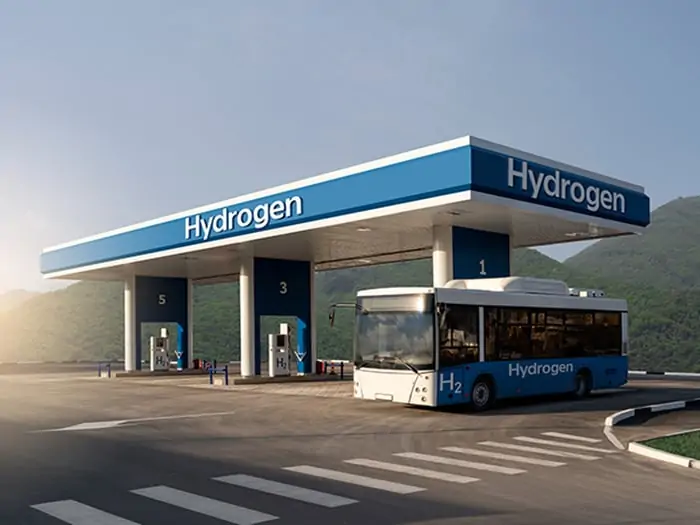
Progressive energy companies are rushing to corner the growing hydrogen market, excited as they see this renewable fuel’s cost steadily drop and as they prioritize decarbonization.
As they work to stay ahead of the pack, they need to put time and thought into building out and implementing these projects. There are complex technical and regulatory considerations; safety is also priority one at every step when managing this flammable, compressed gas.
As the market takes off, there is a need for scaled development along the whole supply chain, and some developers are rising to the occasion for more control and more opportunity. Rather than only build fueling stations, they buy into vertically integrated hydrogen networks to produce, transport and distribute hydrogen. But these multifaceted projects present even more complexity— calling for a team with highly specialized, comprehensive skill sets.
SCS Engineers supports energy companies and contractors looking to diversify their hydrogen services portfolio to include building production plants, including moving the gas via pipeline or truck to offload at fueling stations, ultimately selling to consumers.
“We enter these strategic partnerships to give our clients what they are looking for: a full spectrum of competencies and services; and a proven history of working on hydrogen to deliver turnkey projects. The idea is to take the environmental burden off clients as they pursue these major undertakings,” says Nathan Eady, an SCS vice president, and project manager.
SCS makes site selection; performs environmental due diligence and remediation; feasibility analysis; design and construction of environmental controls; land use, air, and water quality permitting.
The contractors’ specializations are detailed design, engineering, and construction management–from civil to structural to mechanical and fire protection.
This team meets all environmental and regulatory design requirements and develops process safety management and risk management plans with their combined expertise. They also take on the role of community educator, explaining the unique attributes of hydrogen and easing any concerns.
“We take science and engineering and translate that for neighbors and city councils. It’s important to show communities, as well as regulators, that these facilities are designed and operated with the utmost safety,” Eady says.
Requirements vary from jurisdiction to jurisdiction. But with a national reach, SCS sails through processes and regulations by region.
“That matters to our clients; they want to get through the detailed permitting steps and launch as soon as they can to maintain their competitive edge. And when they plan to expand into other regions, they like to know they already have a vetted team in place who knows the territory and can do the work there,” he says.
Permitting and technical considerations vary by location and production method, whether via steam methane reforming (SMR) or electrolysis.
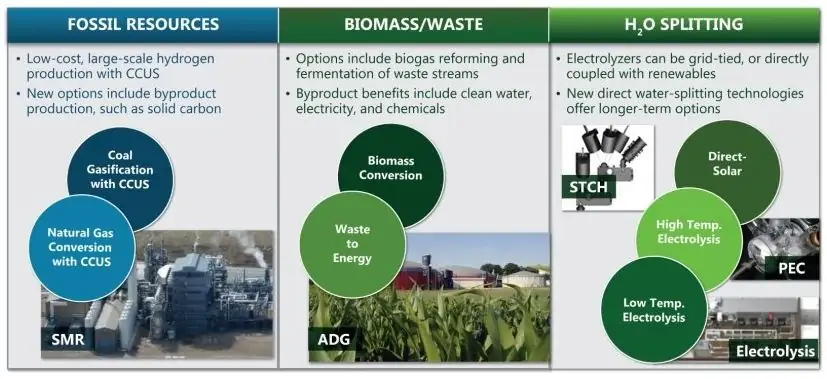
Some operators are taken off-guard by the air quality permitting requirements associated with SMR facilities − or the stringent wildlife and water quality regulations encountered with the larger footprint photovoltaic systems requiring open space to support electrolysis. SCS has the expertise to address the issues, whether state-specific cap and trade regulations for carbon emissions or air basin specific criteria pollutants. SCS also has the unique talent of finding brownfield sites or closed landfill properties, making excellent receiver sites for electrolysis and solar facilities near existing infrastructure.
Building hydrogen projects on these idle properties can save developers significant time and money in the overall project outcome.
“We do a lot of brownfield work helping to clean and redevelop these properties. These sites have special permitting considerations, especially since they typically have a history of industrial use,” Eady says.
SCS performs Phase I Assessments to research records on previous use, and if the team finds a potential problem, they move to Phase II, which entails groundwater and soil testing.
“If we find evidence of existing contamination, we reconcile it so our clients can move forward with the development of their new facilities,” Eady says.
SCS is seeing a growing interest in building hydrogen projects on closed landfills. As brownfields, they have value for their open space and often have some existing infrastructure, offsetting the cost of building new.
“We have done permitting and design work on several closed landfills, sometimes adding solar systems. Hydrogen projects leveraging electrolysis require a tremendous amount of electricity, and when we can bypass the grid enabling clients to make their own electricity, it’s a major plus,” Eady says.
Lately, large energy companies are pivoting from conventional oil and gas to hydrogen, and some smaller, young companies are also joining the clean renewables movement.
SCS has gotten interest from startups looking to obtain government grants and subsidies. Some of these firms need more process engineering support to ensure their new technology can operate at a cost and environmental efficacy equivalent to larger operations.
“We use our knowledge gained working with major conventional energy companies to support these new hydrogen firms in executing successful launches. All in all, a positive trend.”
Together, SCS and its partners play an integral role in helping to see hydrogen continue to climb the energy sector ranks, maintaining an excellent record of accomplishment supporting the planning-design-build of clean-energy plants.
Additional Resources
Accumulating liquids are problematic for landfills taking sludges and other wet wastes not traditionally part of the incoming waste stream. Add to the mix increasing precipitation, and operators could be staring down the perfect storm—especially as they work to optimize their gas extraction systems. Here’s the challenge, explains Pete Carrico, SCS Engineers Senior Vice President and national expert on liquids management:
“Trash is porous, and the soils used for daily and intermediate cover usually aren’t, so liquid gets trapped between alternating trash layers as the landfill fills. These “perched” liquids can drain into well columns and block the slotted portion of the extraction well piping that withdraws gas from waste and into the gas collection system.”
Even a robust vacuum on the wells will not pull gas once pipes fill with fluid. With no path to move it from trash into the collection infrastructure, operators work harder to stave off odor and slope stability issues, among potential resulting problems.
The good news is they have a recourse to remove the liquids, unblock well perforations, and extract more gas. They do it by installing dewatering systems: an intricate network of pneumatic pumps, air lines to power them, and conveyance lines, also known as force mains, to remove liquid.
Manufacturers have designed and redesigned their pumps to try and address problems specific to landfill gas extraction systems. And the equipment does the job but requires meticulous attention and skill to keep all the moving parts going. These liquids are rough on pumps due to their harsh nature. The suspended solids and biological material they contain are the biggest challenges, and if the landfill has high temperatures, these liquids can heat up, further taxing the system, Carrico says.
“No pump indefinitely survives the challenging conditions you have in landfills. So, where we can make the biggest difference is with these maintenance programs,” Carrico says. You’re spending O&M budget on what provides the most impact.”
SCS uses dedicated, factory-trained pump crews who focus solely on operating and maintaining gas extraction dewatering systems. These crews help ensure the infrastructure functions as it should, and gas moves through well piping slots, into the gas header piping, and to the blower/flare station for beneficial end-use.
“Operations run more smoothly with these crews in place. An SCS field crew is as unique as each landfill. Our specialists have various skill sets, i.e., gas collection system monitoring, surface emissions monitoring, or pump maintenance expertise. That’s how we produce better outcomes in terms of pump performance. If you effectively maintain and repair the pumps, you will restore them to their designed specifications, pump more liquids, and with greater ease,” Carrico says.
The teams, who work on landfills across the country, stay busy. One site can have five to 300-plus pumps, each with multiple components, and they must be removed and cleaned frequently.
Replacing worn, fouled, or damaged components is an especially tedious and complex job.
Some wells are 70 to 100 feet deep. Pulling air lines, liquid lines, and pumps out from that depth is hard and requires special equipment to do safely. SCS crews know how to take them apart and put them back together; they don’t just lower them back in the ground after working on them. But hook them up to air and water lines and watch them work at capacity before returning them to service.
It’s a value add; with a good maintenance plan and the right crew, pumps can be kept at their designed specifications and run efficiently for many years. They can typically be cleaned and reset for a fraction of their replacement cost.
“We leverage our size and resources. We have a deep bench of in-house experts and engineers willing to share information to help with problems, which is important as conditions vary at each site, as can problems and solutions. So, it’s important not to do this in a silo but rather pull from our broader knowledge base,” Carrico says.
Technology helps too, especially with tracking, maintaining, and reporting progress to clients. A geographical information system (GIS) maps each well’s location, and pump technicians upload data corresponding to each one from wireless tablets almost instantaneously.
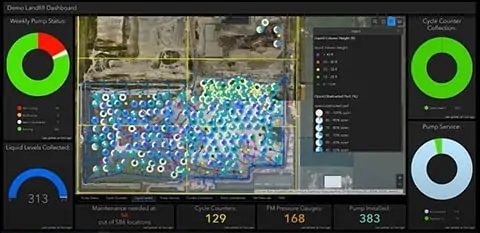
The ability to automate tracking and display critical information right away on a dashboard has increased our program’s efficiency. Technicians spend less time tracking and look at analyses of all the landfill conditions to know where to concentrate their efforts, Carrico says.
A few landfills are working to avoid pumping liquids altogether. They are building large gabion rock structures at the landfill’s base, with piping that connects to the extraction well system, creating a conduit. Liquids automatically drain to the bottom where leachate is intended to go while effectively pulling more gas into the gas collection system.
“This is a newer trend that some of our clients are already doing. And we are involved supporting the well designs,” Carrico says.
For now, in most cases, achieving the best outcomes is about investing in pumps and a good maintenance program.
“Monitoring and regularly measuring—checking stroke-counters, which show how many times a pump cycles, and checking flow meters to know how many gallons a day a system produces are key to finding savings. It’s how you reduce or prevent catastrophic failures,” says Greg Hansen, Senior Project Manager with SCS Field Services Operations, Maintenance & Monitoring.
To execute properly, Hansen provides this advice for operators setting up a pump program:
Have pump maintenance areas with water, electricity, disposal means for waste liquids, and storage facilities for spare parts and tools. More specifically:
Operators planning on doing maintenance in-house should train their technicians on cleaning, servicing, and testing pumps. Either SCS or the pump manufacturer can provide this training.
Above all, Hansen says, “You need a comprehensive OM&M program. The better the job tuning pumps, the better they do in the field, and the longer they work before being cleaned or repaired. It’s a continual process.”
More Resources
Landfill operators forever work to stay on top of a diverse and complex mix of leachate contaminants—heavy metals, ammonia, and biochemical oxygen demand, among them. But lately, they have more to think about, for one: how to keep concentrations of these contaminants within the wastewater treatment plant’s tightening discharge limits. Add to this concern the possibility of more compliance pressure as the list of constituents on regulators’ radar grows. Some operators are preparing for what may be down the pike, from microplastics to PFAS and PFOA—with the latter sometimes called the “elephant in the room.”
Among the strategies, some are exploring on-site leachate treatment options, and there are several. Finding the most fitting, sustainable, and cost-effective one takes vetting. Here is the study of a Florida landfill’s informed decision-making process.
A landfill serving an exploding residential and commercial population recently found itself in a predicament when the overburdened municipal wastewater treatment plant stopped accepting leachate from all county waste operations. Pressed to find a credentialed treatment facility quickly, this SCS Engineers client contracted with a private plant, but the arrangement came with a steep price tag. Overnight, the site’s leachate hauling and disposal costs rocketed from just over three cents a gallon to almost 16 cents a gallon. So, the operator turned to SCS Engineers for help vetting a robust and financially sustainable solution. Ultimately, the client wants to eliminate dependence on a third party and better control its destiny to avoid landing in the same predicament.
In answer, SCS is looking into the feasibility of a system that would clean leachate to drinking water standards to be discharged directly to groundwater. The team is wrapping up a comprehensive study of the site’s current operations, system, and leachate composition as it prepares the client to go out to bid.
“Our goal is to position the landfill to be as independent as possible while providing a cost-effective solution to their leachate treatment,” says SCS Engineers Project Lead Kollan Spradlin. He and the SCS liquid management experts backing him have kicked into high gear because time is money. Right now, the landfill generates about 70,000 gallons a day of leachate through much of the year. In the wet season, that figure spikes to about 150,000 gallons a day. At roughly 16 cents, the landfill can shell out over $24,000 a day for leachate disposal during the wet season.
SCS Engineers’ preliminary work begins with compiling crucial information around current leachate generation and future projections and around site-specific characteristics of the liquids. Next, the team vets multiple leachate treatment systems, sizing up each one against the client’s individual needs to ultimately make a recommendation. And, as important, the team makes sure the operator is very clear on how much upfront capital they need to build an effective, reliable system to do the job.
Spradlin and SCS’s liquid management experts are working on an interim solution while developing a long-term plan. The interim remedy is an evaporator fueled by landfill gas, heats and evaporates water molecules.
“With the evaporator, our client’s private disposal volume is reduced by 50,000 gallons a day, significantly cutting disposal costs. But that’s not enough. We want to reduce that expense further and to manage all or the vast majority of the leachate on-site,” Spradlin says.
The ultimate plan is to design a plant that can treat almost 120,000 gallons a day to a quality that can discharge across a spray field at the facility to groundwater. The landfill saves on disposal costs and owns the system rather than paying for an outside operator’s treatment technology.
This Florida landfill relies on SCS’s site knowledge and its past liquids management experience. SCS’ understanding of the systems and daily operations helped the team develop operational measures already reducing leachate generation to make on-site treatment an option.
“We have completed plan design and construction of their collection, storage, treatment, and disposal systems. And that helped to provide insight into reliable, long-term leachate disposal recommendations,” says Bob Gardner, a 41-year veteran of SCS and part of the team supporting this particular project.
“We had knowledge of site fill sequencing, site conditions, and constraints. And this sped up the process of coming up with a modification that works within their operations and infrastructure,” he says.
All of this foundational background is key to identifying client-centered solutions and presenting a comprehensive data package to vendors. “We give bidders the details they need so they can size their equipment appropriately and provide a more accurate budget estimate. We are trying to eliminate bidder change orders resulting from inadequate background information,” Spradlin says.
The team is thinking ahead, evaluating treatment processes that address a wide range of leachate properties and consider constituents that may be regulated in the future.
“We may put in a reverse osmosis system, a membrane bioreactor, or ultrafiltration to reduce constituent concentrations and take out particulates. We design for flexibility to add more treatment technology on the front end or back end to save the client infrastructure costs in years to come,” Spradlin says.
What differentiates SCS from some other environmental engineering firms is its full-service model and deep bench.
“We touch everything at this landfill. And we have a multidisciplinary team, including national liquid management experts whose knowledge we can tap into at any time. So, we can be one-stop, saving the client from having to go to multiple vendors,” Spradlin says.
Sam Cooke is the lead liquid management expert for this Florida landfill. Like his colleague, Gardner, he knows the wastewater treatment problems landfill operators face; he knows the vendors and their technology. And he understands the importance of relationships—with the client, the state agencies, and every party who is key to the client’s success and the community they serve.
“We fully realize that the wastewater-leachate treatment system we design needs to do its job close to 24/7/365. Moreover, it must do it effectively, sometimes under difficult conditions. So, as we design treatment systems and work with equipment suppliers, facility owners, environmental managers, and treatment system operators, we strive to provide added value and support,” Cooke says.
“In this case, we’re using our knowledge to help our client develop a bid package that addresses specific technical requirements but also meets and helps protect their business and financial goals.”
The team has already met with the regulatory agencies to develop a clear permitting path to accelerate plant deployment and ensure the landfill is fully compliant before making the large transition to direct discharge.
By working with vendors and regulatory representatives well before releasing bid documents, SCS has paved a path to leachate treatment independence.
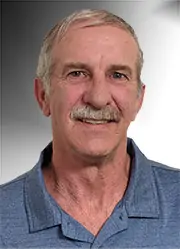
Meet RETA Authorized Instructor (RAI) Daryl Davis. Davis joins the SCS Tracer Environmental training team providing ammonia refrigeration safety, Risk Management Plans, and Process Safety Management certified training.
This SCS team offers comprehensive programs including Ammonia Refrigeration Operator Classes, RETA Certification Review Classes, PSM/RMP & General Duty Clause Safety & Compliance Classes for Ammonia Refrigeration Facilities, Continuing Education, & Custom Training Classes.
SCS’s RAI’s have over 56 combined years of industrial refrigeration expertise. Our trainers use an online delivery system with a live instructor, or on-site, in-person classes, to ensure you continue training for Process Safety Management & Risk Management Program compliance. Hands-on site training can now take place under even noisy plant conditions using high-tech headsets.
RAI – RETA Authorized Instructors have certifications in their mastery teaching advanced refrigeration system concepts and operations at a level that qualifies them to assist CARO, CIRO, CRST, and CRES candidates with their preparations and activities required to earn RETA credentials.
Get the latest in RETA certified training news and classes. The Refrigerating Engineers and Technicians Association (RETA) is the most recognized organization in the U.S. dedicated to the professional development of industrial refrigeration operators and technicians.
The International Awards Committee and Solid Waste Association of North America (SWANA) Board of Directors unanimously voted to honor Tom Conrad, the “C” in SCS, with the Robert L. Lawrence Distinguished Service Award at WASTECON 2021 in November. The Lawrence award is the highest accolade SWANA bestows on a member of the waste management industry, reserved for those making meaningful and lasting contributions.
“I’m honored and humbled to be selected for the Robert L. Lawrence Award. I thank you and am especially thankful for what SWANA and SCS are today,” stated Tom Conrad.
SWANA recognizes Conrad for over 60 years of significant influence on the waste management and environmental services industry. Conrad, a Founder, Executive Vice President, and Director Emeritus of SCS Engineers, dedicated his career to advancing solid waste management, most notably through the founding of SCS Engineers (Stearns, Conrad, and Schmidt Consulting Engineers) more than 51 years ago.
Tom Conrad worked on a wide range of environmental engineering projects touching almost every aspect of solid waste management throughout his career. As an environmental engineering firm and consultant to the newly created US Environment Protection Agency (EPA), the founders recognized that responsible solid waste management was increasingly important for protecting the environment and the health and safety of the general public.
Leading SCS, he helped the EPA develop the first federal regulations for sanitary landfills, managing and capturing landfill gas, waste sorting protocols, sludge management, and land remediation.
Environmental services, including wastewater management, were always a significant part of SCS services and the waste industry. When new regulatory policies began expanding in the ’80s, SCS’s techniques, technology, and expertise helped a broad range of industries comply with environmental needs and continues today with the firm’s greenhouse gas, landfill technology, renewable energy, remediation, and sustainable materials management programs.
Conrad is also known for hiring and mentoring today’s SCS leaders, many of whom are SWANA leaders, by creating and fostering SCS’s culture encouraging employee participation in industry associations, community, and SCS’s mentorship and leadership programs.
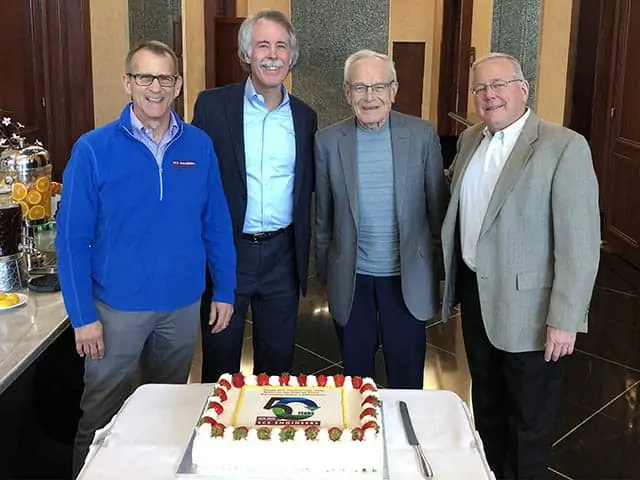
Before his retirement in 2016, Conrad held professional engineering licenses in 24 states. He was a member of SWANA, the American Society of Civil Engineers, the National Waste and Recycling Association, and the Society of American Military Engineers.
He maintains his “work hard – play hard” lifestyle. He is active at SCS, participating in Board of Director meetings and speaking at the Young Professionals Group events and celebrations. While no longer mountain climbing and biking cross-country, he has a vigorous walking, swimming, and biking schedule.
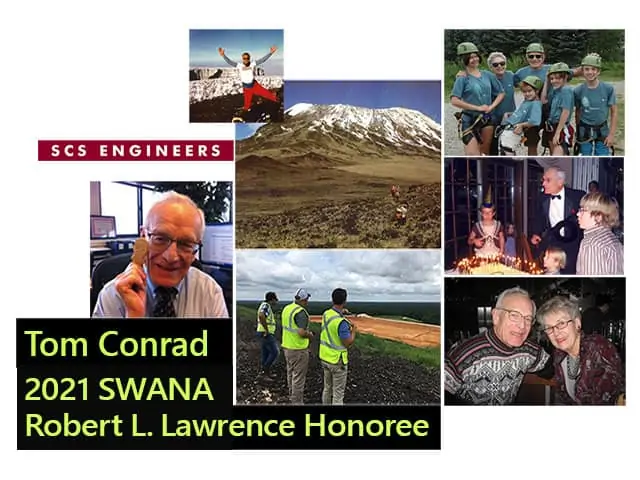
Popular Mechanics recently published an article entitled The Pungent History of America’s Garbage Mountains. The article starts with a little-known ferryman on Lake Michigan when a storm beached his craft on an offshore sandbar in July 1886. Thus started Chicago’s open dump on today’s Lake Shore Drive, home to landmarks such as the Museum of Contemporary Art, the Wrigley Building, the Chicago Tribune Tower, Northwestern University, and the Magnificent Mile – all on turn-of-the-century garbage.
Transportation centers, stadiums, and even entire neighborhoods are now built on landfills. This is a fascinating, well-written article on the history and possibilities of building on remediated properties and brownfields.
“Landfill redevelopment projects tend to be real estate projects, and you know what matters in real estate: location, location, location,” says Mike McLaughlin of SCS Engineers, who specializes in brownfields and landfill redevelopment. “A landfill in an urban area might be the only piece of open land in that area. People go to extraordinary lengths to redevelop because the property is so valuable.”
With the frequency and severity of storms on the rise, municipal solid waste landfill operators have to think differently to keep their workers and environment safe. Planning is key to safely hit the ground running in the wake of severe weather.
Federal law does not hold household hazardous waste (HHW) to the same standards as what is classified as hazardous waste (generated by businesses and received at subtitle C landfills). Yet, these materials have the same compounds and are potentially dangerous too.
“Subtitle D landfills routinely receive these wastes, but under normal conditions, it’s in much smaller quantities, and they are typically segregated. So managing them is not a big deal. But, after a storm, operators can be inundated with these oxidizers, corrosives, flammable gases, and flammable solids. It’s all coming in at once and mixed with other storm debris, posing a risk for reactions and workers’ safety,” says Mike Knox, SCS Quality Advisor. He supports landfill operators in safely managing hazardous wastes. Storm season is a busy time for him and his clients. Those unprepared find themselves pulled in multiple directions and need to act quickly and smartly.
If a structure blows down, it may generate waste that contains gallons of dangerous liquid, gas containers, propane tanks, and pesticides mixed in. It’s dangerous, especially if a waste worker does not see it.
Mike’s Planning Advice
Operators set themselves up for success when they’re ready to go with a plan before that first 80-mile-an-hour wind gust hits.
“You must know how to identify hazardous wastes ahead, train staff ahead, and look at worse-case scenarios ahead,” Knox says.
He and his team start by looking at operators’ facilities and identifying materials, workers’ roles, and available equipment and assets. They identify safety areas and set up classrooms. Important are preparing the staging areas to manage the influx, screen, and segregate by waste type.
Then they look at government rules; help operators determine what they need to do; and execute a plan.
Minimizing Risk
Operators need to secure waste, make sure it’s packaged right, and minimize it where possible to stave off mishaps.
The safety of people and equipment is part of a proactive strategy. Trucks can tip over with heavy, wet loads, so do not overload them. Space trucks in the tipping area are at least 10 feet further apart than the dump trailer is long. For a 30-foot trailer, that’s 40 feet.
Setting up this extra space can be difficult unless you’ve established a large tipping area, and don’t take chances with dump trailers; the results have proven deadly in the past, Knox advises.
Check that backup alarms and strobe lights are working. Train equipment operators to look for vehicles and pedestrians. Do not allow cell phones at the working face; a distraction that no one needs. Mandate the use of high-visibility vests and restrict people to stay within five feet of their vehicle. Strictly control scavenging. People cannot wander and pull items from the trash.
Fuel Up
Fuel is the item most often overlooked in Knox’s experience.
“Having enough fuel to operate heavy landfill equipment and hauling fleets is essential to keep waste moving. Severe storms have impacted fuel supplies for several days to a week or more, so stock up,” he recommends. Mike typically arranges for temporary fuel storage tanks so haulers and heavy equipment operators can stay on their mark through and after the storm.
Scenarios in Preparation
Part of safety management is asking “what if” and then answering ahead of a problem. Depending on where ‘what if’ leads, you prioritize and go after the big things first. One big one is, what if floods occur? That question leads to more specifics to plan for, such as roads likely to be impacted and establishing alternate routes available. What other actions will help traffic flow?
Remember: if there’s a lot of rain or clay, trucks can slip going up hills. So alternate tipping areas that are lower and flatter may be needed to accommodate inclement weather access. “And that takes preparation. Sometimes you have to build a road to reroute to an area you are not using. It can take days,” Knox says.
Building wet weather access roads are important, as are measures like cleaning out stormwater ditches. Nevertheless, know that, depending on location, rising water may flood out areas despite these efforts. Pumping water into berms and ponds from flooded ditches can be a temporary solution if your plan and local regulations allow it. Coordinate with regulatory and permit agencies to set up such actions.
You will want to bolster protections of maintenance facilities, the scale house, and other structures that could be damaged or lose power – stock up on tarps, lumber, and power generators.
Many operators find waste screening towers to be especially useful. Knox and his team will build them in advance to prepare for what’s coming. Waste screeners at the gate radio to active face supervisors if hazardous materials are arriving so they can properly place them, ensuring they are covered with dirt before sending staff to the active face.
Knox completes quality evaluations guided by a 200-item checklist to ensure proper procedures are in place. He compliments this list with many questions to prepare.
Know Your Jurisdiction’s Rules and Storm Accommodations
Operators check local permit conditions to take advantage of possible modifications they may make. Some jurisdictions have more lenient weight restrictions for hauling vehicles or the option to set up temporary staging areas.
Knox also suggests coordinating with the local permit and regulatory agencies following the storm to take advantage of emergency relief funds and coordinate across the area’s public and emergency services.
Local government, emergency responders, regulatory and permitting agencies often have Emergency Operations Centers (EOC) to coordinate resources, information, and crisis management. Mayors, County Commissioners, fire departments, hospitals, police, environmental regulatory agencies, and other key industry leaders are typically part of this team.
These groups practice response coordination and stage tabletop exercises or mock disasters. “Take time to participate and plan with the EOC. Check for whatever else may be available in your area to help prepare, and work as a team with these local entities to respond to severe weather or other emergency events,” Knox says.
Circling Back to Planning
“Knowing what to do before the storm hits will make your recovery easier. You will keep your employees, your community, and your site safe. And be ready to go back to normal operations much faster.”

The recent MWEA Conference covered a wealth of other important topics on water management and safety, including this presentation with SCS Engineer’s Remote Monitoring Control specialist, Brett Heist. Brett and Jarod Stuyvesant co-presented “More Than a Pretty Map – GIS Covers Your Assets,” including demonstrations of how the City of Zeeland is using GIS to enhance the efficiency of maintenance and inspection activities and improve the reliability of physical infrastructure throughout its community, leading to increased public safety and financial savings.
Click here to view these demos!
DEMOS: There are some unique methods to plan for capital improvements and streamline data storage and access being implemented in the City of Zeeland. The City has an integrated GIS map for its storm, sanitary, water, and streets, including information about each asset within the system: material, size, inverts, condition, business risk, and even televised inspection videos for some of the storm and sanitary lines.
The GIS maps’s information is used daily by public works and to create a comprehensive capital improvement map that the City uses to plan for 5-year improvements, significantly improving planning and budgeting efficiency while ultimately providing the public with safer infrastructure.
Features include televised inspection videos attached to a respective asset after uploading and accessible with the click of a mouse. Access entire buildings in the same manner as horizontal assets using a 3D online viewer.
The Zeeland Clean Water Plant RAS Building: Using AutoCAD data, the City created a 3D GIS viewer of this building and its assets. Asset information, such as blower and pump sizes and operation and maintenance tasks, are accessible without having to sort through shop drawings and as-builts.
Another example of implementing 3D GIS data like this is for MobileGR who uses a 3D GIS model to store asset data and maintenance tasks for every one of their nine parking ramps in downtown Grand Rapids.
Media Borough, Pennsylvania’s Food Compost Program uses a witty video encouraging participation in its organic waste diversion and composting program. We had to share – not only is it fun – it works!
The Borough launched its pilot program to gauge the feasibility of adding food scrap collection to its current recycling efforts. This month the program is available to all residents. The food scrap collection program provides residents the opportunity to separate food from the rest of their household waste for collection and composting at a local compost farm.
Media Borough estimates it has 70% recycling participation in the community – that’s an impressive number. Its current recycling and yard waste programs divert close to 30% of residential solid waste from landfills and incinerators. Adding a food scrap collection program can reduce residential waste by another 30% and create compost.
The Borough’s Public Works website explains the reasons why organic matter, matters.
Thank you to this Pennsylvania community and its Public Works department for helping to sustain future generations with their reduce, reuse, and recycling actions. We hope by sharing their video and results, we’ll see greater participation in communities nationwide.
The EPA and, in some cases, states are rolling out new emissions guidelines at least as stringent. The EPA estimates that the plans could cover about 1,600 landfills. These landfills are in 41 states, tribal entities, and the U.S. territories of Puerto Rico and the Virgin Islands.
MSW landfills without Gas Collection and Control Systems (GCCS) that reach a specific threshold will need to add these systems and have 30 months to install or update control systems to meet new standards. As you’ve noticed by now, we’ve greatly oversimplified what is happening.
The new regulations and timetables are difficult to understand and untangle. SCS Engineers, in concert with SCS Field Services, have prepared resources to help during the transition period and afterward when landfills are likely to need more monitoring and measurement, thus creating millions of more bits of data to store, analyze, and report.
We hope you find these resources useful. We will be publishing more soon.
These resources may help you with future monitoring and maintenance: